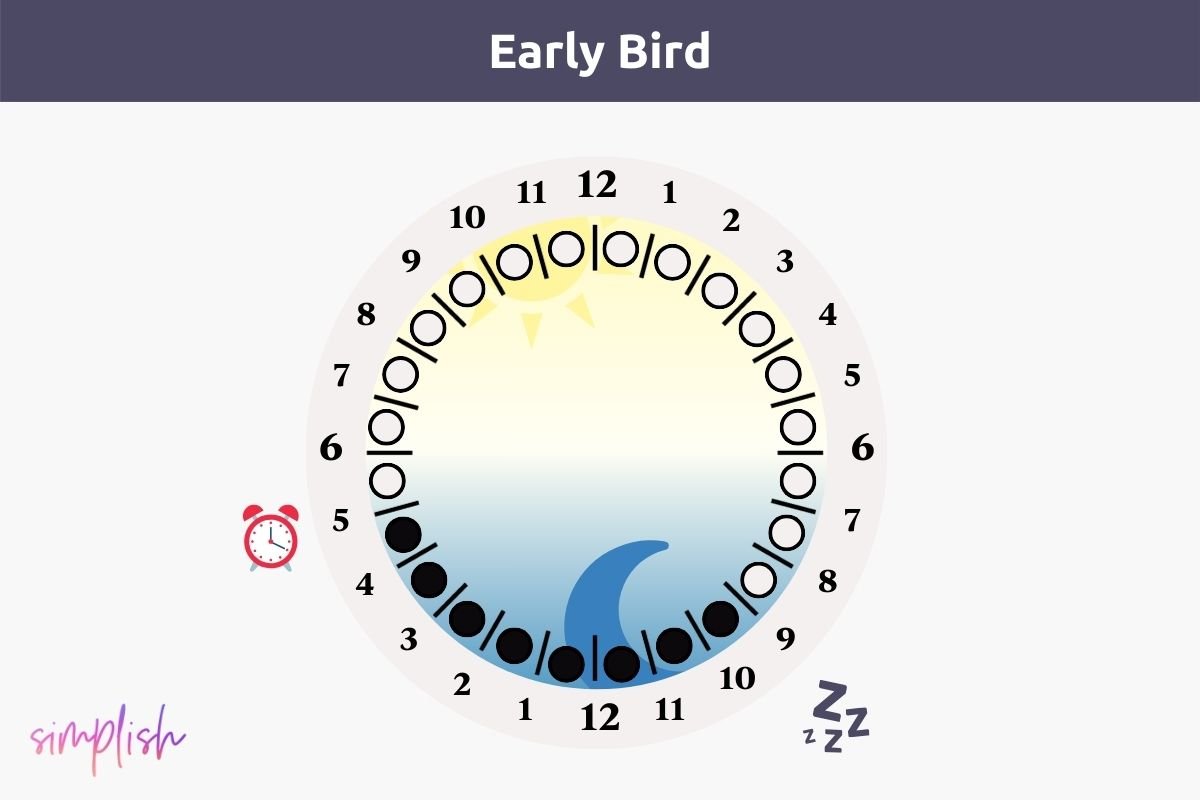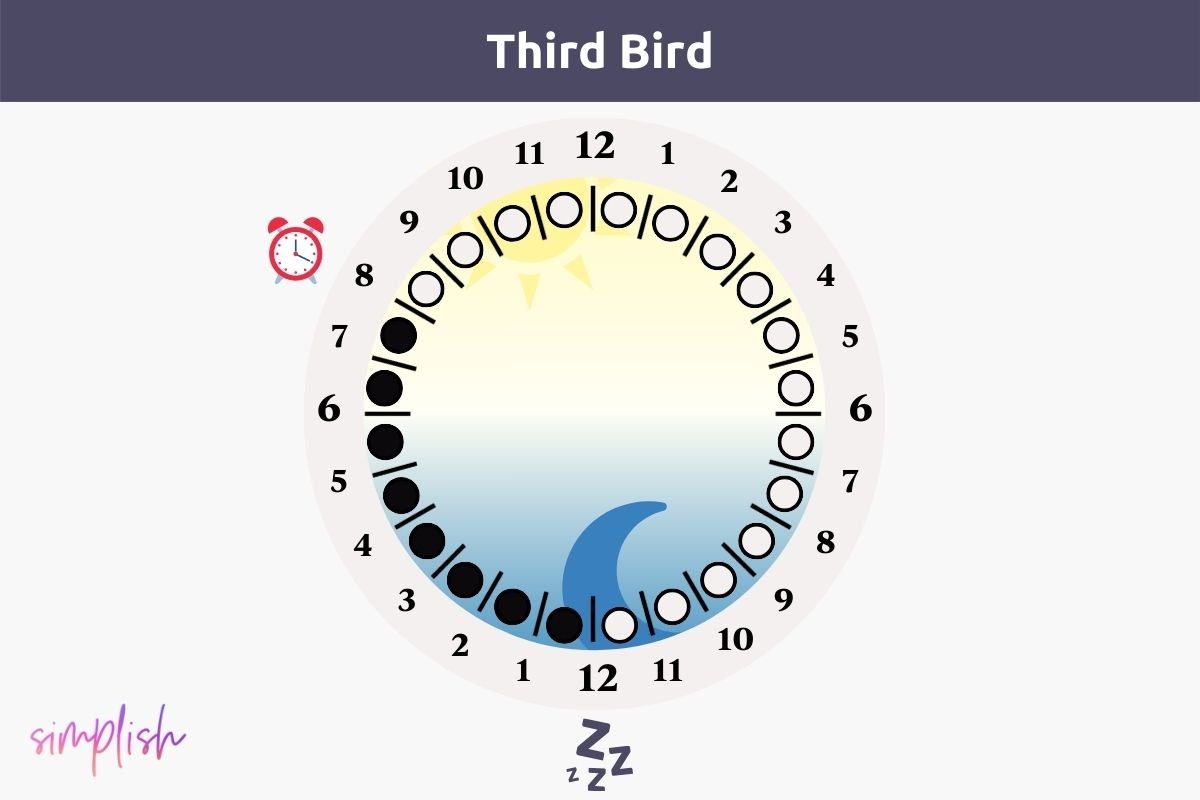Circadian Rhythm Charts by Chronotype (Explained)
Your body has an internal clock.
Instead of telling time, it regulates your energy in sync with the sun. It’s known as the circadian rhythm, and it orchestrates all of your body's rhythms throughout the course of a day.
☀️ At sunrise, your body prepares to tackle the day. Hormones that regulate wakefulness peak in preparation to help you get things done.
🌚 At sunset, your body sends signals to rest up as you prepare for sleep. Hormones that regulate sleep peak to help you get rest.
By understanding your unique circadian rhythm , you can align your activity level with your body’s natural sleep/wake cycle to be more productive - and feel great while getting things done. In this article, learn about your internal clock with circadian rhythm charts customized to your chronotype (night owls 👀 we see you) to help you visualize how rest works into your daily routine.
What Is A Circadian Rhythm?
Your circadian rhythm is a biological clock that operates 24 hours a day. It regulates your energy level, alertness intensity, and fatigue based on the time of day. Unlike any other clock you may be familiar with, your body's clock does not come with a snooze button, and you can’t stop it from running.
The term circadian derives from the Latin circa diem, which means “approximately a day” (i.e. everyone’s internal clock is tune just a bit differently). There are several things this internal clock controls, like body temperature, hormone secretion, and even the digestive system, which all work together to regulate when you feel sleepy and when you’re ready to get going. It works with the help of the suprachiasmatic nucleus located in the hypothalamus (a part of our brain), and responds to the changing light (as the sun rises and sets).
How Circadian Rhythms Impact Wellbeing and Productivity
The better you understand your circadian rhythm, the more effectively you will manage your time. Imagine a man stranded on a desert island with a limited food supply. He must ration it to survive – eating too slowly means starvation, while eating too quickly leads to running out soon.
The same thing happens with your energy. Trying to do more than your body can handle might lead to low energy, burnout, and even, over time, illness. With the help of the circadian rhythm, your body regulates its own energy resources throughout the day and night.
By understanding your body's rhythm and respecting it with breaks like resting or exercising, you will make the most of your body's energy. Your body is not a machine, so it is crucial to take a break when you feel overly tired. In the long run, living in harmony with your biological clock will maximize your time and give you more energy.
Cortisol and Peak Alertness
Our circadian rhythm relies on specific biological cues to keep itself in sync, and one of these cues is a hormone called cortisol. This hormone plays a crucial role in managing our energy levels throughout the day and acts in contrast to melatonin, the sleep-inducing hormone.
As the chart shows, cortisol levels rise when morning approaches, usually around 6 am, giving us that boost to become more alert and ready for the day ahead. Light exposure and physical activity can further increase cortisol secretion, making us feel even more awake and active.
As day progresses into the evening, cortisol secretion gradually decreases, and that's when melatonin takes the spotlight. Melatonin levels start to rise, signaling to our body that it's time to wind down and preparing your body to fall asleep. It's a natural process that helps us transition from being active during the day to getting the rest you need at night.
We need both cortisol and melatonin to function, as these are essential players in our circadian rhythm, ensuring we're awake and productive during the day and allowing us to unwind and recharge at night.
24 Hour Sleep-Dream-Wake Cycle
With a better understanding of hormones, let's take a closer look at how they drive your daily rhythm. A healthy circadian rhythm is like a 24-hour body clock that never stops ticking. It spans your active daytime with elevated cortisol levels and helps you drift off to sleep at night. People naturally feel inclined to sleep between midnight and 6 am, especially around 2 to 4 am.
Even during sleep, your body experiences distinct phases that influence how refreshed you are upon waking. Getting a good night's rest isn't as simple as it sounds, so let's break it down. When sleeping, you cycle continuously through two distinct stages: REM (rapid eye movement) sleep and deep sleep (non-REM sleep). Everyone’s sleep cycle varies slightly in length, but the average length of a full sleep cycle is around 90 minutes. Here’s what happens in each:
REM (rapid eye movement) sleep is the phase of rest where your mind is actively dreaming, and your heart rate increases slightly.
Deep sleep is the phase associated with feeling restful. In deep sleep, your breathing and heart rate slow down, and your body relaxes more deeply.
A good night's sleep requires both of these stages to take place, and experts recommend aiming for at least five of these cycles each night to ensure a good night's rest.
Circadian Rhythm Charts According to Chronotype
You may have heard of early birds or night owls. These references correspond to a concept known as your "chronotype”.
Essentially, chronotype refers to your body's natural tendency to sleep at specific times. You may be an early bird who thrives in the morning, tackling tasks with vigor, or alternatively, you may find your creative spark ignites as the sun sets. Understanding what pattern you fall into will make you maximize your day as much as possible.
The Early Bird Chronotype
Early birds, also known as “Larks,” are those whose creativity and potential to work efficiently peak in the early morning hours. Around 6 am, their cycles begin, and by 9 pm, their energy begins to decline.
Here are some tips you can follow if you're an early bird and want to maximize your chronotype:
Harness your morning creativity: Kickstart your day by dedicating the first hours to creative tasks. When you first wake up in the morning, your mind is fresh and imaginative, making it the perfect time to brainstorm new ideas for the day ahead.
Optimal problem-solving zone: Between 8 am and 12:30 pm, the cognitive abilities of Early Birds tend to be at their peak. Take advantage of this period for tackling complex or challenging tasks requiring focus and analytical thinking.
Take power naps to perk up: When you feel your energy dipping during the day, consider taking short power naps. A quick nap, around 20-30 minutes, can help you recharge and boost your alertness.
Embrace the daylight: Use light exposure to your advantage. Your cortisol levels will peak with sunlight exposure, and your internal clock will be more stable, improving your sleep. Remember that artificial light does not work the same way as natural light.
Manage caffeine intake: Keep an eye on your caffeine consumption, especially in the latter part of the day. As an early bird, excessive caffeine in the afternoon or evening may disrupt your sleep later on, although it can temporarily boost your energy.
The Night Owl Chronotype
Those who belong to this chronotype are most productive in the late hours of the day. Night people are usually more productive between 18:00 and 1am, which might shock Early Birds.
Here are some tips for those who love the night and are most productive during that time of day.
Make breakfast a priority: You should never skip breakfast in the morning. Although night owls tend to wake up later in the morning, a nutritious breakfast will fuel your body and provide you with energy throughout the day.
Avoid late-night snacks: Avoid the temptation of late-night snacks even if you are wide awake. Eating close to bedtime can disrupt your sleep and digestion. If you feel especially hungry, opt for a light, healthy snack a few hours before bedtime.
Keep a regular sleep schedule: Make sure you go to bed and wake up at the same time every day, even on weekends. Having a solid daily routine will make you sleep better and feel more relaxed.
Get moving with regular exercise: Incorporate physical activity into your daily routine. When you're a night owl, it can be difficult to squeeze workouts into your day without missing out on social opportunities. Still, regular exercise improves sleep quality, reduces stress, and boosts your health.
The Third Bird Chronotype
When it comes to sleep patterns, there exists a middle ground between early risers and night owls. This is where the "third bird" comes into play. Suppose you don't hit your peak productivity at 6 am or 6 pm. In that case, you might belong here, with your prime moments taking a bit longer to arrive and sleepiness settling in around 11 pm.
In case you feel that you fall into this category, you might find these tips helpful:
Reduce screen time in the evening: Avoid using electronic devices like phones, tablets, and computers close to bedtime. This will overstimulate your brain, preventing you from falling asleep again. Screens emit blue light, which interferes with melatonin production (the hormone that makes you tired), making it hard to rest.
Wind down before bed: Create a relaxing bedtime routine to signal your body that it's time to sleep. Read or practice relaxation techniques instead of engaging in stimulating activities. This will make your sleep schedule more consistent and help you sleep better in the long run.
Stay active: This is one of the best ways to stay healthy and reduce stress simultaneously. It can either be done in the morning or evening.
Make the most of your morning: It does not matter that you don't wake up as early as Larks. Take advantage of your time in the early hours, and try incorporating morning habits that will help you tackle your assignments easily.




